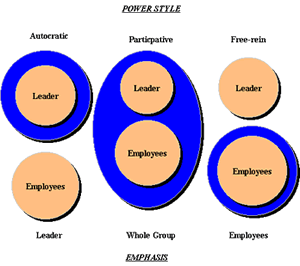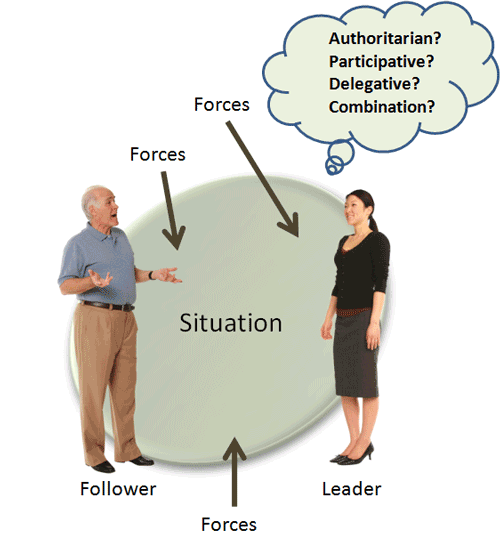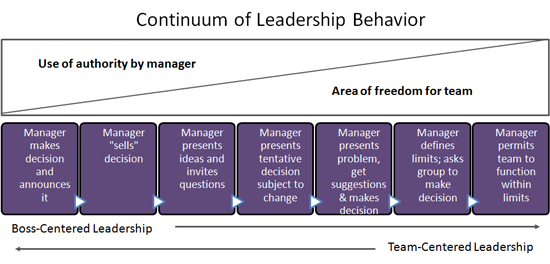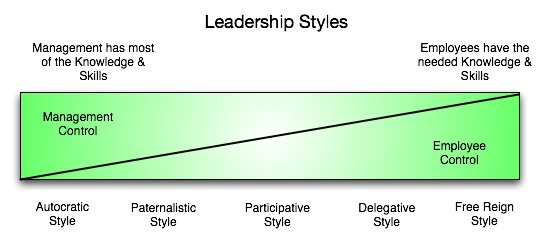Leadership Styles
Leadership style is the manner and approach of providing direction, implementing plans, and motivating people. As seen by the employees, it includes the total pattern of explicit and implicit actions performed by their leader (Newstrom, Davis, 1993).
The first major study of leadership styles was performed in 1939 by Kurt Lewin who led a group of researchers to identify different styles of leadership (Lewin, Lippit, White, 1939). This early study has remained quite influential as it established the three major leadership styles: (U.S. Army, 1973):
-
authoritarian or autocratic - the leader tells his or her employees what to do and how to do it, without getting their advice
-
participative or democratic - the leader includes one or more employees in the decision making process, but the leader normally maintains the final decision making authority
-
delegative or laissez-fair (free-rein) - the leader allows the employees to make the decisions, however, the leader is still responsible for the decisions that are made

Although good leaders use all three styles, with one of them normally dominant, bad leaders tend to stick with one style, normally autocratic.
Authoritarian or Autocratic Leadership

I want both of you to. . .
This style is used when leaders tell their employees what they want done and how they want it accomplished, without getting the advice of their followers. Some of the appropriate conditions to use this style is when you have all the information to solve the problem, you are short on time, and/or your employees are well motivated.
Some people tend to think of this style as a vehicle for yelling, using demeaning language, and leading by threats. This is not the authoritarian style, rather it is an abusive, unprofessional style called “bossing people around.” It has absolutely no place in a leader's repertoire.
The authoritarian style should normally only be used on rare occasions. If you have the time and want to gain more commitment and motivation from your employees, then you should use the participative style.
Participative or Democratic Leadership

Let's work together to solve this. . .
This style involves the leader including one or more employees in the decision making process (determining what to do and how to do it). However, the leader maintains the final decision making authority. Using this style is not a sign of weakness, rather it is a sign of strength that your employees will respect.
This is normally used when you have part of the information, and your employees have other parts. A leader is not expected to know everything—this is why you employ knowledgeable and skilled people. Using this style is of mutual benefit as it allows them to become part of the team and allows you to make better decisions.
Even if you have all the answers, gaining different perspectives and diversity of opinions normally provide greater creativity than insularity. As Katherine Phillips wrote,
So as you think about diversity and its effects in organizations during this tough economic time, recognize that the most robust practical value of diversity is that it challenges everyone in an organization. We are more thoughtful, and we recognize and utilize more of the information that we have at our disposal, when diversity is present. That is diversity’s true value.
Delegative or Laissez-faire Leadership

You two take care of the problem while I go. . .
In this style, the leader allows the employees to make the decisions. However, the leader is still responsible for the decisions that are made. This is used when employees are able to analyze the situation and determine what needs to be done and how to do it. You cannot do everything! You must set priorities and delegate certain tasks.
This is not a style to use so that you can blame others when things go wrong, rather this is a style to be used when you fully trust and have confidence in the people below you. Do not be afraid to use it, however, use it wisely!
NOTE: Laissez-faire (or lais·ser faire) is the noninterference in the affairs of others. [French : laissez, second person pl. imperative of laisser, to let, allow + faire, to do.]
Forces

A good leader uses all three styles, depending on what forces are involved between the followers, the leader, and the situation. Some examples include:
-
Using an authoritarian style on a new employee who is just learning the job. The leader is competent and a good coach. The employee is motivated to learn a new skill. The situation is a new environment for the employee.
-
Using a participative style with a team of workers who know their jobs. The leader knows the problem, but does not have all the information. The employees know their jobs and want to become part of the team.
-
Using a delegative style with a worker who knows more about the job than you do. You cannot do and know everything and the employee needs to take ownership of her job! In addition, this allows you to be more productive.
-
Using all three styles: Telling your employees that a procedure is not working correctly and a new one must be established (authoritarian). Asking for their ideas and input on creating a new procedure (participative). Delegating tasks in order to implement the new procedure (delegative).
Forces that influence the style to be used include:
-
Amount of time available
-
Are relationships based on respect and trust or on disrespect?
-
Who has the information—you, the employees, or both?
-
How well your employees are trained and how well you know the task
-
Internal conflicts
-
Stress levels.
-
Type of task, such as structured, unstructured, complicated, or simple?
-
Laws or established procedures, such as OSHA or training plans
Continuum of Leader Behavior
In 1958 Tannenbaum and Schmidt (1973) expanded on Lewin, Lippit, and White's three leadership styles by extending them to seven styles and placing them on a continuum as shown in the diagram below:

Notice that as you go from left to right, it moves from manager-oriented decision making to team or subordinate oriented decision making, thus the team’s freedom increases while the manager’s authority decreases. Depending upon the present level of your team's experience and skills, you select a starting point and as the team grows and develops, you move from on to the next one:
-
Manager makes decision and announces it – The team has no role in the decision-making role. Coercion may or may not be used or implied.
-
Manager “Sells” decision – Rather than just tell, the manager needs to sell the decision, as there is a possibility of some resistance from team members.
-
Manager presents ideas and invites questions – This allows the team to get a fuller explanation so they can gain a better understanding of what the manager is trying to accomplish.
-
Manager presents a tentative decision that is subject to change – This action invites the team to have some influence regarding the decision; thus, it can be changed based on the team's input.
-
Manager presents the problem, gets suggestions, and then makes the decision – Up to this point the manager has always presented the decision, although the last style allows it to change based upon the team's input. Now the team is free to come up with options, however, the manager still has the final say on those options.
-
Manager defines limits, and requests the team to make a decision – The manager delegates the decision making to the team; but instills specific limits on the team's solution.
-
Manager allows team to function within limits – Now the team does the decision making, however, the manager's superior may have placed certain limits on the options they can make. If the manager sits in on the decision making, he or she attempts to do so with no more authority than the other members do.
Basically, the first two styles or behaviors are similar to the authoritarian style, the next three are similar to the participative style, while the last two are similar to the delegative style. This approach gives the leader more options that can be refined to specific situations or environments.
5+2 Major Behavior Patterns of Leaders
This page describes seven behavior patterns or styles of leaders, to include Social Leadership as described by Howell and Costley (2001).
Positive and Negative Approaches
Leaders approach their employees in different ways. Positive leaders use rewards, such as education, new experiences, and independence, to motivate employees, while negative employers emphasize penalties (Newstrom, Davis, 1993). The negative approach has a place in a leader's repertoire of tools in certain situations; however, it must be used carefully due to its high cost on the human spirit.
Negative leaders act domineering and superior with people. They believe the only way to get things done is through penalties, such as loss of job, days off without pay, reprimanding employees in front of others, etc. They believe their authority is increased by frightening everyone into higher levels of productivity. Yet, what normally happens when this approach is used is that morale falls, which leads to lower productivity.
Most leaders do not strictly use one or another, but are somewhere on a continuum ranging from extremely positive to extremely negative. People who continuously work out of the negative are bosses, while those who primarily work out of the positive are considered great leaders.
A similar theory is McGregor's Theory X and Theory Y.
Use of Consideration and Structure
Two other approaches that leaders use are (Stogdill, 1974):
- Consideration (employee orientation) — leaders are concerned about the human needs of their employees. They build teamwork, help employees with their problems, and provide psychological support.
- Structure (task orientation) — leaders believe that they get results by consistently keeping people busy and urging them to produce.
There is evidence that leaders who are considerate in their leadership style are higher performers and are more satisfied with their job (Schriesheim, 1982).
Also notice that consideration and structure are independent of each other, thus they should not be viewed on a continuum (Stogdill, 1974). For example, a leader who is more considerate does not necessarily mean that she is less structured.
Blake and Mouton's Managerial Grid is a good example of a leadership model based upon the concept of consideration and structure.
Paternalism
Paternalism has at times been equated with leadership styles. Most definitions of leadership normally state or imply that one of the actions within leadership is that of influencing. For example, the U.S. Army (1983) uses the following definition:
Leadership is influencing people by providing purpose, direction, and motivation while operating to accomplish the mission and improving the organization.
The Army further goes on by defining influence as:
A means of getting people to do what you want them to do. It is the means or method to achieve two ends: operating and improving. But there is more to influencing than simply passing along orders. The example you set is just as important as the words you speak. And you set an example—good or bad—with every action you take and word you utter, on or off duty. Through your words and example, you must communicate purpose, direction, and motivation.
Paternalism is defined as (Webster Dictionary):
A system under which an authority undertakes to supply needs or regulate conduct of those under its control in matters affecting them as individuals as well as in their relationships to authority and to each other.
Thus, paternalism supplies needs for those under its protection or control, while leadership gets things done. The first is directed inwards, while the latter is directed outwards.
Geert Hofstede (1997) studied culture within organizations. Part of his study was on the dependence relationship or Power Difference—the extent to which the less powerful members of an organization expect and accept that power is distributed unequally. Hofstede gave this story to illustrate the concept of Power Difference:
The last revolution in Sweden disposed of King Gustav IV, whom they considered incompetent, and surprising invited Jean Baptise Bernadotte, a French general who served under Napoleon, to become their new King. He accepted and became King Charles XIV. Soon afterward he needed to address the Swedish Parliament. Wanting to be accepted, he tried to do the speech in their language. His broken language amused the Swedes so much that they roared with laughter. The Frenchman was so upset that he never tried to speak Swedish again.
Bernadotte was a victim of culture shock—never in his French upbringing and military career had he experienced subordinates who laughed at the mistakes of their superior. This story has a happy ending as he was considered very good and ruled the country as a highly respected constitutional monarch until 1844. (His descendants still occupy the Swedish throne.)
Sweden differs from France in the way its society handles inequality (those in charge and the followers). To measure inequality or Power Difference, Hofstede studied three survey questions from a larger survey that both factored and carried the same weight:
- Frequency of employees being afraid to express disagreement with their managers
- Subordinates' perception of their boss's actual decision making style (paternalistic style was one choice)
- Subordinates' preference for their boss's decision-making style (again, paternalistic style was one choice)
He developed a Power Difference Index (PDI) for the 53 countries that took the survey. Their scores range from 11 to 104. The higher the number a country received, the more autocratic and/or paternalistic the leadership, which of course relates to employees being more afraid or unwilling to disagree with their bosses. While lower numbers mean a more consultative style of leadership is used, which translates to employees who are not as afraid of their bosses.
For example, Malaysia has the highest PDI score, being 104, while Austria has the lowest with 11. And of course, as the story above illustrates, Sweden has a relative low score of 31, while France has a PDI of 68. The United States' score is 40. Note that these scores are relative, not absolute, in that relativism affirms that one culture has no absolute criteria for judging activities of another culture as “low” or “noble”.

Keeping the above in mind, it seems that some picture paternalistic behavior as almost a barbaric way of getting things accomplished. Yet, leadership is all about getting things done for the organization. And in some situations, a paternalistic style of decision-making might be required; indeed, in some cultures and individuals, it may also be expected by not only those in charge, but also by the followers.
That is what makes leadership styles quite interesting—they basically run along the same continuum as Hofstede's PDI, ranging from paternalistic to consultative styles of decision making. This allows a wide range of individual behaviors to be dealt with, ranging from beginners to peak performers. In addition, it accounts for the fact that not everyone is the same.
However, when paternalistic or autocratic styles are relied upon too much and the employees are ready for a more consultative type of leadership style, then it can becomes quite damaging to the performance of the organization if change is not advanced.
Next Steps
Learning Activity: Leadership Style Survey
Next chapter: Character and Traits of Good Leaders
Related page: Path-Goal Theory
References
Hofstede, G. (1997). Culture and Organizations: Software of the Mind. New York: McGraw-Hill.
Howell, J.P., Costley D.L. (2001). Understanding Behaviours for Effective Leadership. NJ: Prentice-Hall.
Lewin, K., Lippit, R., White, R.K. (1939). Patterns of aggressive behavior in experimentally created social climates. Journal of Social Psychology, 10, 271-301.
Newstrom, J.W., Davis, K. (1993). Organizational Behavior: Human Behavior at Work. New York: McGraw-Hill.
Schriesheim, C.A. (1982). The Great High Consideration: High Initiating Structure Leadership Myth: Evidence on its Generalizability. The Journal of Social Psychology, April, 116, 221-228.
Stogdill, R.M. (1974). Handbook of Leadership: A Survey of Theory and Research. New York: Free Press.
Tannenbaum, A.S., Schmidt, W.H. (1973). How to Choose a Leadership Pattern. Harvard Business Review Reprint, 36, May-June, 4-12.
U.S. Army. (1983). Military Leadership. Field Manual 22-100. Washington, DC: U.S. Government Printing Office.
